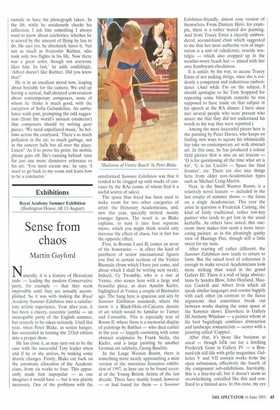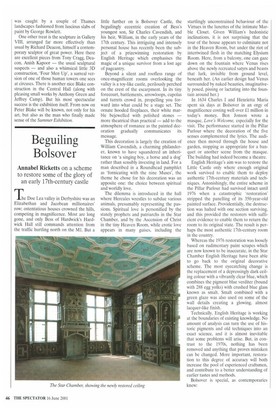Royal Academy Summer Exhibition (Burlington House, till 13 August)
Sense from chaos
Martin Gayford
Naturally, it is a feature of Herculean tasks — leading the modern Conservative party, for example — that they seem impossible until they are actually accomplished. So it was with making the Royal Academy Summer Exhibition into a satisfactory artistic experience. Year after year, it has been a cheery, eccentric jumble — an inescapable party of the English summer, but scarcely to be taken seriously. Until this year, when Peter Blake, as senior hanger, has succeeded in turning the 233rd edition into a proper show.
He has done it, as may turn out to be the case with the successful Tory leader when and if he or she arrives, by making some drastic changes. Firstly, Blake cut back on the automatic allocation of the Academicians, from six works to four. This apparently made him unpopular — as one imagines it would have — but it was plainly necessary. One of the problems with the unreformed Summer Exhibition was that it tended to be clogged up with stacks of canvases by the RAs (some of whom find it a useful source of sales).
The space thus freed has been used to make room for two other categories of artist: the Honorary Academicians, and, new this year, specially invited, mainly younger figures. The result is, as Blake explains, to turn it into four separate shows, which you might think would only increase the effect of chaos, but in fact has the opposite effect.
First, in Rooms I and II, comes an array of the honoraries — in effect the kind of pantheon of senior international figures you find in certain sections of the Venice Biennale (from which I have just come, and about which I shall be writing next week). Indeed, Cy Twombly, who is a star at Venice, also scores here with a large and beautiful piece, as does Anselm Kiefer, highlighted at Venice a couple of Biennales ago. The hang here is spacious and airy by Summer Exhibition standards, where the norm is a Black-Hole-of-Calcutta density of art which would be familiar to Turner and Constable. This is especially true of Room II, where there is a memorial display of paintings by Balthus — who died earlier in the year — happily coexisting with some abstract sculptures by Frank Stella, the Kiefer, and a large painting by another German art celebrity, Georg Baselitz.
In the Large Weston Room, there is something more nearly approaching a mini version of the notorious Sensation exhibition of 1997, as here are to be found several of the Young British Artists of the last decade. These have mainly found, however — or had found for them — a Summer Exhibition-friendly, almost cosy version of themselves. From Damien Hirst, for example, there is a rather muted dot painting. And from Tracey Emin a cheerily embroidered, second-hand chair which suggested to me that her most authentic vein of inspiration is a sort of valedictory, seaside nostalgia — which also cropped up in the weather-worn beach hut — mixed with her own flamboyant cheekiness.
It is unfair, by the way, to accuse Tracey Emin of not making things, since she is evidently a competent and industrious embroiderer. (And while I'm on the subject, I should apologise to Sir Tom Stoppard for repeating some blimpish remarks he was supposed to have made on that subject in his speech at the RA dinner; I have since met several people who were present who assure me that they did not understand his words in the way they were reported.) Among the most successful pieces here is the painting by Peter Davies, who keeps on finding new ways to square his whimsically hip take on contemporary art with abstract art. In this case, he has produced a colour field picture that is also an art lexicon — 'IQ is for questioning all the time what art is for', is for Uccello — Space the final frontier', etc. There are also nice things here from older non-Academician types such as Michael Craig-Martin.
Next, in the Small Weston Room, is a relatively novel feature — included in the last couple of summer shows — the focus on a single Academician. This year the artist in question is Frederick Cuming, the kind of fairly traditional, rather low-key painter who tends to get lost in the usual kerfuffle. As others have noted, this oneroom show makes him seem a more interesting painter, as in the pleasingly quirky view of Hastings Pier, though still a little sweet for my taste.
After starting off rather different, the Summer Exhibition now tends to return to form. But the raised level of coherence is enough to make several Academicians look more striking than usual in the grand Gallery III. There is a wall of large abstractions by Sandra Blow, John Hoyland, Maurice Cockrill and Albert Irvin which all speak similar languages and coexist happily with each other (in contrast to the fierce arguments that sometimes break out between works sharing the same space at the Summer show). Elsewhere in Gallery III Anthony Whishaw — a painter whom at his best beguilingly combines abstraction and landscape romanticism — scores with a painting called 'Coppice'.
After that, it's more like business as usual — though lo'bk out for a fetching Frederick Gore in Gallery IV — a Bonnard-ish still-life with girlie magazines. Galleries V and VII contain works from the open submission, effectively the fourth of the component sub-exhibitions. Inevitably, this is a free-for-all, but it doesn't seem so overwhelming, corralled like this and confined to a limited area. In this zone, my eye was caught by a couple of Thames landscapes fashioned from luscious slabs of paint by George Rowlett.
One other treat is the sculpture in Gallery VIII, arranged far more effectively than usual by Richard Deacon, himself a contemporary sculptor of great power. Here there are excellent pieces from Tony Cragg, Deacon, Anish Kapoor — the usual sculptural suspects — and also a whimsical little 3D construction, Tour Men Up', a surreal version of one of those human towers one sees at circuses. There is another nice Blake construction in the Central Hall (along with pleasing small works by Anthony Green and Jeffrey Camp). But his most spectacular success is the exhibition itself. From now on Peter Blake will be known, not only for his art, but also as the man who finally made sense of the Summer Exhibition.



































































 Previous page
Previous page